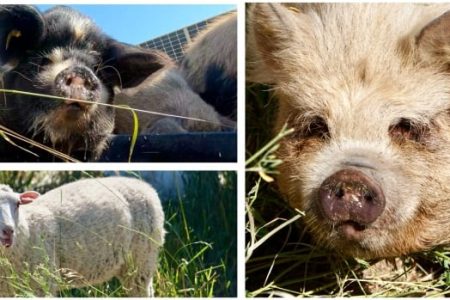Under a blistering sun, Janna Grier hops out of her pickup truck to start moving hoses to fill up water troughs for her flock of sheep. One thousand of the shaggy, four-legged animals are spending their third summer at a solar farm about 40 kilometres east of Calgary.
Their job is simple: Eat weeds.
Grier and her crew are tasked with managing the land and ensuring none of the vegetation grows tall enough to block the sun from shining down on the nearly 110,000 solar panels on 130 hectares of prairie.
“A lot of people look at weeds and they don’t want them around and we see them as a food source, right? Most of them are really high in protein. The sheep enjoy consuming them,” said Grier, who began farming 15 years ago.
This summer, the flock has a few new friends with short snouts to lend a helping hand (or mouth). Grier is testing out eight female kunekune pigs, a breed originally from New Zealand.
On this day, Grier moves the pigs to a new area to graze. “Come on ladies,” she calls, as they plod along behind her.
“In the next five to 10 years, we’re going to see tons of solar development and so there’s huge potential for it,” said Grier, as she puts up a new temporary fence for the animals.
The growing number of large-scale solar fields has created an increased need for animals to help control the weeds and other vegetation. Using the same piece of land for both solar and agriculture is known as “agrivoltaics.” The concept is not new, but is growing in popularity, especially with new government rules on the horizon.

Sheep are the most common form of agrivoltaics because they reduce the need for herbicides and lawn mowing, which can kick up stones and break panels.
Research is underway to explore what other types of animals could be used on solar sites. Another area of focus by researchers is what types of crops could grow between and underneath the long rows of solar panels.
The proliferation of solar fields in rural areas has created some conflict as the renewable energy projects can change the landscape that was traditionally agricultural. The use of agrivoltaics though, can help mend fences.
“We start thinking about agriculture at our solar projects on day one,” said Janet Annesley, chief sustainability officer with Kiwetinohk Energy, a Calgary-based energy company proposing to build three solar farms in Alberta.
The company’s proposed 400-megawatt Homestead project would be the second largest solar field in the country.
“Many of our landowners would like to see some continuation of agricultural…
Read More: Booming solar industry has a growing appetite for weed-chomping crews

